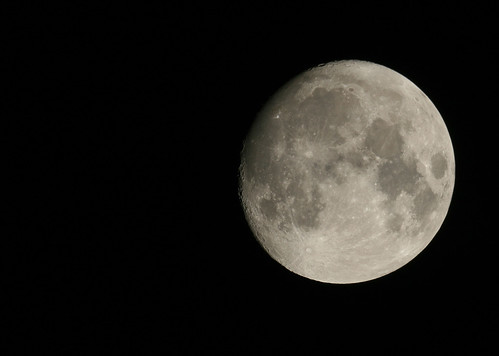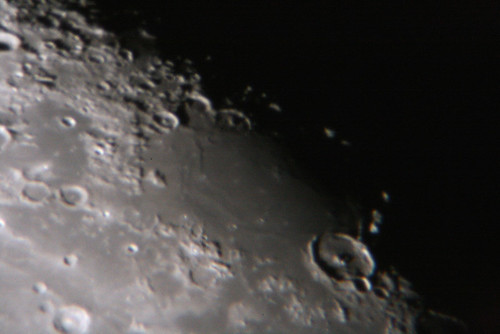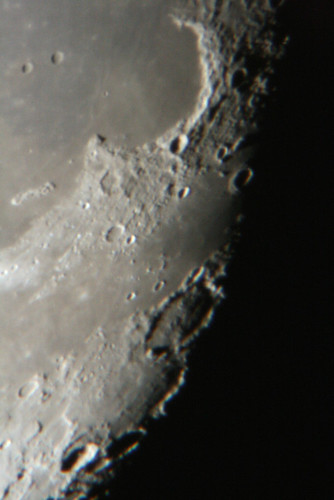So I set up the telescope this evening to try and experiment some with astrophotography. My intent was to test out my Canon 7D on deep sky objects using the Astronomic CLS clip filter to block out light pollution. Unfortunately, I hadn't realized tonight was a full moon night--the moon is so bright it washes out all the deep sky objects I'd want to photograph. Disappointed, I tried using the 7D to shoot the moon, but "seeing" was fairly crummy--there was so much turbulence in the upper atmosphere the moon appeared to be boiling, and all my shots turned out blurry.
On the verge of packing up, I got the notion to try a few shots with my Canon 50D we'd converted to infrared. I'd not tried any astrophotography with it before, but I'd heard IR can cut through bad atmosphere. Guess what? It did! Using prime focus with my telescope as the lens, the 50D got this fairly sharp image of the moon--and quite a few more like it--easily. Emboldened, I thought I'd attempt some eyepiece projection shots, in which an eyepiece is inserted in the image train to get significantly more magnification. Alas, I discovered several things when I attempted this. 1) My 50D's image sensor is covered with dust and crap that showed up really, really badly on these high-magnification images, 2) highest magnifications make the image too dim for my camera to register, and the ISO of 3200 isn't high enough to compensate, and 3) my GSO plossl eyepieces produce a fairly intense infrared hot spot right in the center of the image, yuck. But still, this is an interesting shot for a session that was, more or less, a bust.
Now Playing:
Chicken Ranch Central
Showing posts with label moon. Show all posts
Showing posts with label moon. Show all posts
Thursday, May 15, 2014
Monday, December 27, 2010
Waxing Gibbous Moon, Dec. 27, 2010
Yesterday I was struck by the intensely clear skies overhead, lacking even the ubiquitous brownish haze along the horizon. The front that'd blown through at Christmas really cleared the air, in a literal fashion. After my futile attempt to observe and photograph the solstice lunar eclipse last week, the astronomy bug had taken hold of me again. A quick check of the San Antonio Clear Sky Chart:

Showed that not only were conditions quite favorable for clear-sky observations, the rest of the week would be obscured by clouds. So it was now or never, to overstate the drama a bit. The only drawback would be that temperatures would drop below freezing. For this Texas boy, that's a significant obstacle to overcome, but I made the effort.
During my ill-fated eclipse shoot last week, I had major halation issues with the type of eyepiece projection photography I was attempting, so moved the primary mirror of my telescope up several inches for prime astrophotography. The resulting lunar image was very, very sharp and I wanted to experiment some more. Unfortunately, by the time I made the decision to set up, the sun had already gone down, and in the poor lighting conditions my polar alignment of my scope was mediocre at best. Good polar alignment allows long time exposures of the night sky, as the motor drives the telescope to track the sky as it appears to move overhead. Early test shots of the Pleiades and Orion Nebula was disappointing. Achieving accurate focus through the camera was exceptionally difficult, but even worse, exposures longer than 5 seconds resulted in stars elongated into streaks. Again, poor polar alignment.
Eventually I gave up on shooting any Deep Space Objects, and decided to wait for the moon to rise. Checking online, I expected moon rise at around 11:30, and figured I could shoot by midnight, or 12:30 at the latest. Turns out I got sloppy and looked up the pacific timezone table or somesuch, because it was 12:30 before the moon started peeking over the rooftops of my neighborhood. I was tired, cold and cranky by that time, and couldn't even entertain myself by random astronomical observations, because, you know, prime focus and all that. Eventually, I got this shot, and broke everything down by 2 a.m.

The shot above is the best of approximately 50 shots. Unlike my sharp pre-eclipse photo last week, with the air still and clear, the moon this night was still fairly low in the sky, and turbulence was rampant. Through the scope, it appeared as if the sky were boiling in front of the moon, and distorting it as you might expect. The trouble is that the turbulence causes focus to come and go. I had to discard many shots in which southern craters were very sharp, but northern mountains were fuzzy. Or the mountains were sharp, but the lunar horizon was blurred. It was a mess. Waiting until the moon was at the zenith might have cured those problems, but then again, might not. I wasn't about to stay up until 4 a.m. to find out. I'll get some better lunar photos some day, but until then, this will have to do.
Now Playing: Talking Heads Stop Making Sense
Showed that not only were conditions quite favorable for clear-sky observations, the rest of the week would be obscured by clouds. So it was now or never, to overstate the drama a bit. The only drawback would be that temperatures would drop below freezing. For this Texas boy, that's a significant obstacle to overcome, but I made the effort.
During my ill-fated eclipse shoot last week, I had major halation issues with the type of eyepiece projection photography I was attempting, so moved the primary mirror of my telescope up several inches for prime astrophotography. The resulting lunar image was very, very sharp and I wanted to experiment some more. Unfortunately, by the time I made the decision to set up, the sun had already gone down, and in the poor lighting conditions my polar alignment of my scope was mediocre at best. Good polar alignment allows long time exposures of the night sky, as the motor drives the telescope to track the sky as it appears to move overhead. Early test shots of the Pleiades and Orion Nebula was disappointing. Achieving accurate focus through the camera was exceptionally difficult, but even worse, exposures longer than 5 seconds resulted in stars elongated into streaks. Again, poor polar alignment.
Eventually I gave up on shooting any Deep Space Objects, and decided to wait for the moon to rise. Checking online, I expected moon rise at around 11:30, and figured I could shoot by midnight, or 12:30 at the latest. Turns out I got sloppy and looked up the pacific timezone table or somesuch, because it was 12:30 before the moon started peeking over the rooftops of my neighborhood. I was tired, cold and cranky by that time, and couldn't even entertain myself by random astronomical observations, because, you know, prime focus and all that. Eventually, I got this shot, and broke everything down by 2 a.m.

The shot above is the best of approximately 50 shots. Unlike my sharp pre-eclipse photo last week, with the air still and clear, the moon this night was still fairly low in the sky, and turbulence was rampant. Through the scope, it appeared as if the sky were boiling in front of the moon, and distorting it as you might expect. The trouble is that the turbulence causes focus to come and go. I had to discard many shots in which southern craters were very sharp, but northern mountains were fuzzy. Or the mountains were sharp, but the lunar horizon was blurred. It was a mess. Waiting until the moon was at the zenith might have cured those problems, but then again, might not. I wasn't about to stay up until 4 a.m. to find out. I'll get some better lunar photos some day, but until then, this will have to do.
Now Playing: Talking Heads Stop Making Sense
Wednesday, July 16, 2008
Waxing gibbous moon
There are several different types of astrophotography. The simplest is using a regular camera with a normal lens to take shots of the sky. Slightly more advanced is the "piggyback" method of strapping the camera and lens onto a motor-driven telescope to take advantage of tracking motions for a long-duration exposure. With the "afocal" method, you simply hold a camera and lens up to a telescope eyepiece and shoot the image there. "Eyepiece projection" takes this a step further, removing the camera lens and using an eyepiece as a lens instead, while attaching the assembly to the scope with a T-mount and adapter. And "Prime Focus" dispenses with the eyepiece all together, using the telescope itself as a large lens. My scope was designed specifically with wide-field, prime focus astrophotography in mind, although until last night, I'd never attempted it (or at least, never attempted it properly).
To accommodate the focal plane of the camera (which is different from the human eye) I had to move the primary mirror forward about two inches inside the telescope tube. I'd never done this before, but it went smoothly with the mirror lining up perfectly in the pre-drilled holes (as far as I know, the scope's previous owner never did this, either). This necessitated re-collimation to ensure the mirrors were properly aligned. During this step, part of the brittle plastic housing on the secondary mirror spider popped off. Simply broke and fell away. This threw everything out of whack, but I eventually straighted things out. Sadly, this indicates a new spider assembly isn't something I can put off purchasing as long as I'd hoped to be able to.
There are two significant drawbacks with Prime Focus astrophotography for my scope. First is that since the mirror's position is changed, the scope can't be focused for visual observing. Unlike eyepiece projection, I can't switch back and forth--I'm committed to photography at that point. The second is that unlike eyepiece projection, where I can simply switch out eyepieces to get different magnifications, the magnification is set in stone with Prime Focus. Essentially, my scope becomes a 762mm f/5 prime lens. No zoom. There are benefits, however. The scope as a lens offers great wide-field, deep-space views for astrophotography (especially if the polar alignment and tracking are working properly). It's also a lot brighter without eyepieces in the mix, making focusing somewhat easier (this continues to be the biggest difficulty I've had with astrophotography).
last night clouds rolled in from the north, negating any chance of polar alignment, so I fell back to the old standby of the moon and believe I've gotten my sharpest image of our satellite yet:

I also took a series of Jupiter photos, which was fairly small in the image but showed the Galilean moons clearly. I'll see if I can tweak the images to get something worth posting. I tried some deep-sky imaging as well of starfields and the like, but the wind kicked up and shook the scope too much for anything worthwhile. I did catch a faint streak of a satellite passing overhead, which was nifty, but beyond the novelty factor the images wasn't worth keeping.
Now Playing: Herb Alpert & the Tijuana Brass The Lonely Bull
To accommodate the focal plane of the camera (which is different from the human eye) I had to move the primary mirror forward about two inches inside the telescope tube. I'd never done this before, but it went smoothly with the mirror lining up perfectly in the pre-drilled holes (as far as I know, the scope's previous owner never did this, either). This necessitated re-collimation to ensure the mirrors were properly aligned. During this step, part of the brittle plastic housing on the secondary mirror spider popped off. Simply broke and fell away. This threw everything out of whack, but I eventually straighted things out. Sadly, this indicates a new spider assembly isn't something I can put off purchasing as long as I'd hoped to be able to.
There are two significant drawbacks with Prime Focus astrophotography for my scope. First is that since the mirror's position is changed, the scope can't be focused for visual observing. Unlike eyepiece projection, I can't switch back and forth--I'm committed to photography at that point. The second is that unlike eyepiece projection, where I can simply switch out eyepieces to get different magnifications, the magnification is set in stone with Prime Focus. Essentially, my scope becomes a 762mm f/5 prime lens. No zoom. There are benefits, however. The scope as a lens offers great wide-field, deep-space views for astrophotography (especially if the polar alignment and tracking are working properly). It's also a lot brighter without eyepieces in the mix, making focusing somewhat easier (this continues to be the biggest difficulty I've had with astrophotography).
last night clouds rolled in from the north, negating any chance of polar alignment, so I fell back to the old standby of the moon and believe I've gotten my sharpest image of our satellite yet:

I also took a series of Jupiter photos, which was fairly small in the image but showed the Galilean moons clearly. I'll see if I can tweak the images to get something worth posting. I tried some deep-sky imaging as well of starfields and the like, but the wind kicked up and shook the scope too much for anything worthwhile. I did catch a faint streak of a satellite passing overhead, which was nifty, but beyond the novelty factor the images wasn't worth keeping.
Now Playing: Herb Alpert & the Tijuana Brass The Lonely Bull
Monday, July 14, 2008
Humor and Sinus
Still experimenting with astrophotography on my newly-restored telescope, and still producing far more trash than keepers. But I think I'm making a wee bit of progress. Frustratingly, I have yet to get a Jupiter shot even close to the quality of this one I shot two weeks' back when I was just playing around. It's still insanely difficult to focus my camera accurately, even when using a variety of different Hartmann Mask focusing aids. But I persevere, staying up late losing sleep looking at the stars rather than writing. Here're two shots I got last night.

This is Mare Humorum, the "Sea of Moisture," on the moon near the terminator. That large crater in the lower right corner is Gassendi. I took this shot using my T-mounted Canon Rebel XTi with a 2x Barlowed 9mm plossl lens on a 6" f/5 Newtonian reflector for those of you keeping track at home. The focus isn't perfect, but it's close.

The crescent in the upper portion of the photo is Sinus Iridium, which opens up to the flat expanse of Mare Imbrium. The huge crater halfway down the image is J. Herschel, so old that much of its crater wall has been eroded away by other meteorite impacts. It still cuts a pretty striking image among the dark shadows of the lunar terminator. This image was captured with the same settings as the one above.
Now Playing: Billy Joel The Bridge

This is Mare Humorum, the "Sea of Moisture," on the moon near the terminator. That large crater in the lower right corner is Gassendi. I took this shot using my T-mounted Canon Rebel XTi with a 2x Barlowed 9mm plossl lens on a 6" f/5 Newtonian reflector for those of you keeping track at home. The focus isn't perfect, but it's close.

The crescent in the upper portion of the photo is Sinus Iridium, which opens up to the flat expanse of Mare Imbrium. The huge crater halfway down the image is J. Herschel, so old that much of its crater wall has been eroded away by other meteorite impacts. It still cuts a pretty striking image among the dark shadows of the lunar terminator. This image was captured with the same settings as the one above.
Now Playing: Billy Joel The Bridge
Subscribe to:
Posts (Atom)

